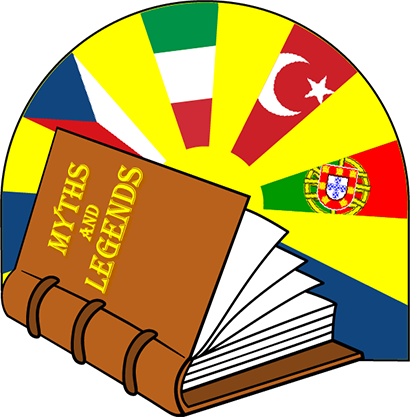Project description
Project "Myths and Legends" investigates the contribution of myths and legends to the formation of the socio-cultural structure of the European Union, and also the knowledge of European citizens about the myths and legends. Its aims are to develop our understanding of different cultures and how they can be integrated, to contribute to the construction of a common European culture. With help of this project we want to increase and improve our communication in foreign languages and consequently to learn them. As the main target groups are teachers and students of participating schools, we would like to support the active participation of the pupils. They will discover and study national and international myths and legends. The results of their work will be brochure with 2 or 3 myths from each country, presented in English and all national languages. Another important output is performance. Pupils will perform one national myth and together with all partners one international myth. Application of performance (show) for language learning is one of the innovative approaches.
Teachers, pupils and researchers will be exchange their data, information and experiments in a collaborative space (e.g. website, E-twinning Desktop) dedicated to the project. In addition, participants will learn how to use various means of communication such as Facebook, Google chat, E-twinning , how to use modern technology (smartphones, tablets) in their lessons. This is the further contribution to innovation in education.
There are about 50 teachers and about 60 pupils who will participate in the international project meetings and student exchanges. But much more will work on project during 2 years in their schools so the impact on at least 2000 pupils and 200 teachers from participating schools is expected. The main expected impacts are: an increase of the interest of teachers in usage of ICT means and various programs in teaching, deepening knowledge of the partner countries cultures and increase of awareness of different cultures.
As part of the project preparation we had prepared a questionnaire, which was created to show whether pupils from partner schools know some national and international myths and legends. Approximately 350 respondents participated in the survey, 150 respondents from the Czech Republic and 50 from other countries. The first finding was that it is very difficult for students to find the difference between a myth and a legend. In addition, it was shown that the concept of a myth and a legend is understood a little differently in each country. Therefore, the project will focus firstly on defining terms and comparing the two approaches to this issue at various partner schools. The survey of awareness about the myths and legends showed that the results are mostly very similar. Generally, it can be said that pupils know national myths and legends better than the international ones. As in the Czech Republic and also in Italy, approximately 30% of the students knew no national myth or legend. It was different for international ones - approximately 50% of respondents from the Czech Republic did not any. The results in Italy were even better than the ones concerning the national myths and legends- only 10% of Italian respondents did not know any. In Portugal, the results were more balanced - 30% of respondents did not know any national myth or legend and 40% of respondents did not know any international one. Slightly worse results were reflected in answers of students from Turkey (50% - 60% did not know any national or international myth), which was certainly influenced by the age of respondents – they were significantly younger than pupils from other schools.
The students and teachers who are the active participants of the project will introduce the myths and legends of the country by using Movie Maker, Microsoft Office Publisher and MS Power Point programs. This study method will provide presentations in new ways for teachers.
In this project, cultural and historical experience is important because all countries are teaching national and international legends and myths in different lessons (Social sciences, History, Music or Literature ). That is why the partners will show legends and myths to the other partners. And all partners will see the similarities and differences in the legends and myths in the European Union countries. Students and teachers will also see that a lot of cultural implementation is based on various legends and myths. The teachers and students will firstly study the myths and legends of their own countries and then they will transfer their knowledge to the participants of the partner countries through different presentation techniques. Participants of all the project partner countries will learn about the myths and legends in their native country. Firstly the direct participants will benefit from the products of the project, but in the continuation of the activities even other classes and students will watch the movies and presentations. In the end, all the target groups will have the information about the myths and legends which have affected the European countries.
Myths and legends are often closely linked with religion. The involvement of a school from predominantly Muslim areas with a strong influence of Asian culture (Turkey) and schools from countries with Christian traditions (Italy, Portugal, the Czech Republic) will bring useful information and a comparison. An interesting aspect of the involvement may be the situation in the Czech Republic, which is in contrast to other countries because its inhabitants are mainly atheists.
The teachers and students from different European countries who will participate in the project will understand that Europe is a common place, we are important parts of Europe and all the European citizens have grown up with all the myths and legends of Europe.


